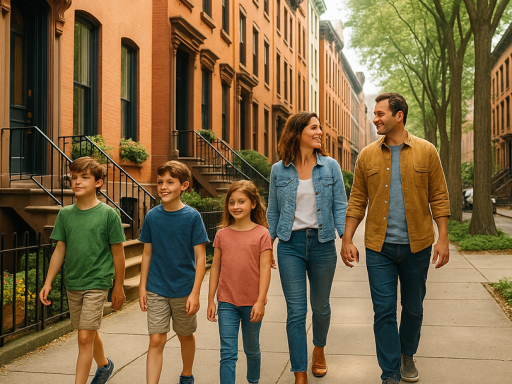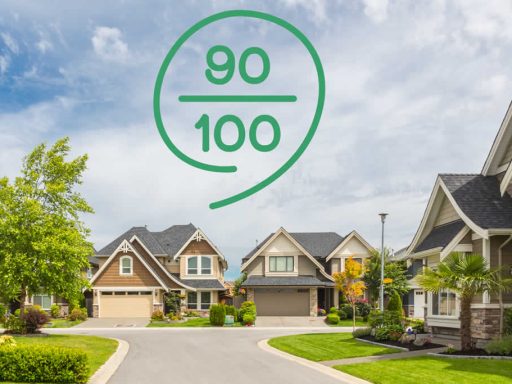Rethinking Convenience in the Modern City
For decades, the dream of homeownership was defined by square footage and backyard space. Today, that dream looks different. Homebuyers are increasingly prioritizing proximity over property size, convenience over commute, and connection over isolation. The new measure of a great neighborhood isn’t how far it stretches, but how close everything feels. From coffee shops and corner stores to parks, schools, and public transit, people want communities where everyday life happens within a short walk or bike ride.
This concept, known as the 15-minute neighborhood, has quickly evolved from an urban planning theory into one of the most transformative real estate trends in recent memory. It’s based on a simple idea: that residents should be able to meet most of their daily needs within 15 minutes of home. What started as a sustainability movement in major cities like Paris has now become a defining feature of livability across North America. And according to Proximitii’s data, these neighborhoods don’t just make life more convenient—they enhance value, community, and overall quality of life.
What Exactly Is a 15-Minute Neighborhood?
The 15-minute neighborhood is built on accessibility, equity, and well-being. It reimagines urban life by designing communities where schools, parks, shops, healthcare, and entertainment are all within reach. Originally envisioned for dense city cores, this idea is now reshaping suburban centers, small towns, and even rural hubs that have developed around vibrant local corridors.
Cities like Portland, Austin, and Toronto have already adopted elements of the model through zoning reforms, mixed-use development, and expanded transit systems. But the real momentum is happening at the neighborhood level. Proximitii’s hyperlocal data shows that “15-minute living” can take many forms—from revitalized downtown districts to compact suburban town centers—so long as they support easy access to everyday essentials.
Is It About Walking or Driving?
When people hear “15-minute neighborhood” or “15-minute city,” they often think of driving distance—but that’s not the idea. The 15 minutes refers to walking or biking, not driving. It’s about human-scale accessibility, where most daily needs can be reached without getting behind the wheel.
In urban settings, that typically means everything is within a half-mile radius. In suburban or mixed environments, it can extend to short bike rides or quick transit connections. The goal is to reduce car dependency and make communities more livable, healthy, and sustainable.
This distinction matters, because a neighborhood that’s truly “15-minute” friendly feels fundamentally different—it’s designed for people, not traffic. Proximitii’s walkability and amenities data directly capture this concept, showing which communities allow residents to move effortlessly through daily life on foot or by bike.
The Data Behind the Trend
Behind the appeal of 15-minute living lies a wealth of measurable indicators that define what people value most about where they live. Proximitii’s data, drawn from more than 300 unique neighborhood metrics, consistently points to the same themes:
Neighborhoods with high proximity to grocery stores, restaurants, and parks have stronger livability scores and higher resident satisfaction. Commute efficiency, particularly for hybrid and remote workers, has become one of the most decisive livability factors. Local entertainment, shopping, and outdoor recreation contribute to steady housing demand, even during market slowdowns. And as air quality, green space, and walkability improve, so do perceptions of community well-being.
In essence, the numbers support what homebuyers already feel intuitively. Convenience has become the new measure of luxury, and neighborhoods that offer it tend to hold their value—and their residents—longer.
Why Homebuyers Are Shifting Toward Walkable Living
The growing preference for 15-minute living reflects more than changing commuting habits; it signals a lifestyle realignment around time, health, and connection.
Lifestyle Integration
Buyers today are looking for neighborhoods that make life effortless and enjoyable. They want to start their morning at a local café, take their kids to a nearby park, and pick up groceries without getting in a car. This kind of environment fosters spontaneity and community, making people feel more connected to where they live.
Time as the Ultimate Currency
Remote work and flexible schedules have made people more aware of how much time they spend in transit. Long commutes are increasingly viewed as unnecessary sacrifices. A 15-minute neighborhood gives that time back—time that can be spent on relationships, hobbies, or simply enjoying daily life.
Financial and Environmental Benefits
Owning fewer cars, driving less, and living near amenities saves households thousands of dollars annually while reducing environmental impact. It’s a lifestyle that aligns with both modern economics and sustainability goals, appealing to a generation that values efficiency and eco-conscious living.
Developers and Cities Are Taking Notice
Real estate developers and city planners are responding to these shifts by designing communities around walkability and mixed use. Dense downtowns are being reimagined as pedestrian-friendly cultural districts, while suburban developments are adding local retail, community spaces, and transit connectivity.
In Austin, neighborhoods like Mueller showcase the power of mixed-use design, offering homes, shops, parks, and offices within easy reach. Portland continues to lead the way with bike-friendly infrastructure and compact community planning. In Toronto, transit-oriented developments are creating vibrant “villages” where everything a resident needs is just minutes away.
This approach not only increases property values but also builds stronger local economies and social cohesion. The future of real estate is no longer defined by how far you can drive—it’s by how much life you can reach on foot.
How Proximitii Data Captures the 15-Minute Lifestyle
Proximitii’s Local Insights Reports are uniquely designed to quantify the lifestyle advantages of a 15-minute neighborhood. Each report includes over 300 hyperlocal data points, ranging from walkability and transportation access to wellness, housing, and community indicators.
The walkability section highlights proximity to restaurants, parks, entertainment, and shopping. Transportation data reveals public transit accessibility and average commute times. Environmental measures show air quality, green space, and sustainability markers. Combined with housing affordability and demographic profiles, this creates a comprehensive snapshot of what living in that neighborhood truly feels like.
By layering these dimensions together, Proximitii enables buyers, renters, and agents to understand not just what a property costs, but how well it aligns with the 15-minute lifestyle.
The Agent Advantage: Turning Data Into Connection
For real estate agents, the 15-minute neighborhood trend represents a powerful shift in how they communicate value to clients. Sharing a branded Proximitii Local Insights Report helps agents go beyond traditional listings by illustrating what life is like around the home—not just inside it.
Agents who can discuss nearby parks, grocery stores, schools, and commute options position themselves as trusted neighborhood experts. These insights build credibility, nurture engagement, and help clients visualize their daily routine in a new community. In a market where lifestyle often drives decisions more than price, data-backed storytelling has become a competitive advantage.
Are 15-Minute Neighborhoods the Future of Real Estate?
All evidence suggests that they are, though in different forms across different regions. In dense cities, the 15-minute model might mean access to transit, nightlife, and local commerce. In smaller towns, it might mean walkable main streets and strong local networks. Even in rural areas, the rise of “micro-hubs” shows how communities are adapting to bring essential services closer together.
The beauty of the model is its flexibility. It doesn’t prescribe how people should live—it simply ensures they can live well without sacrificing convenience or connection.
Measuring Livability in Minutes, Not Miles
Traditional real estate metrics often rely on broad averages at the city or zip-code level, but real life doesn’t happen in averages. Proximitii’s hyperlocal approach measures livability block by block, capturing the unique mix of amenities, transportation, and community features that shape a resident’s experience.
Two neighborhoods in the same city can offer entirely different lifestyles, even if they share the same median price point. By quantifying proximity, accessibility, and well-being, Proximitii turns the 15-minute ideal into something measurable, comparable, and actionable.
Health, Happiness, and Human Connection
At its core, the 15-minute neighborhood is not just about real estate—it’s about rediscovering the rhythm of local life. Studies consistently show that people who live in walkable, connected communities experience lower stress, higher physical activity, and a greater sense of belonging. They shop locally, interact with neighbors, and take pride in their surroundings.
This sense of connection builds stronger, more resilient communities. It also reflects a broader cultural shift toward human-centered living—where well-being, sustainability, and design coexist seamlessly. The 15-minute neighborhood represents not just a new way to plan cities, but a better way to live in them.
The Bottom Line
The 15-minute neighborhood has become more than a planning philosophy—it’s a consumer expectation. Homebuyers want to live where their time is valued, their needs are close, and their surroundings support a balanced, fulfilling lifestyle.
With tools like Proximitii’s Local Insights Reports, both agents and buyers can see beyond the listing price to understand the deeper layers of livability that define modern real estate decisions. The next wave of real estate success will belong to those who can interpret and deliver this data-driven vision of proximity, purpose, and possibility.
The question isn’t whether the 15-minute neighborhood will shape the future—it already is. The only question left is how close you are to living in one.






